CMI 501: Principles of Leadership and Management Report
VerifiedAdded on 2022/11/30
|15
|4735
|362
Report
AI Summary
This report delves into the core concepts of leadership and management, exploring how these principles contribute to organizational success. It examines the impact of legal status on governance, emphasizing the importance of ethical conduct and compliance. The report analyzes the purpose of organizational mission and vision statements, highlighting their role in guiding strategy and communicating values to stakeholders. It further investigates the influence of organizational structures on management roles and the significance of aligning management styles with the chosen structure. The impact of organizational values and ethics on decision-making is discussed, underscoring their role in establishing standards of conduct and motivating employees. The report also explores the relationship between management and leadership, discussing various styles, their impact on teams and individuals, and the influence of culture and values on these styles. The report also covers the essential skills and knowledge required for effective leadership, communication techniques, and the behaviors necessary for success. Finally, it provides insights on building a culture of trust and respect within teams. This report is a valuable resource for understanding the complexities of leadership and management in an organizational context.
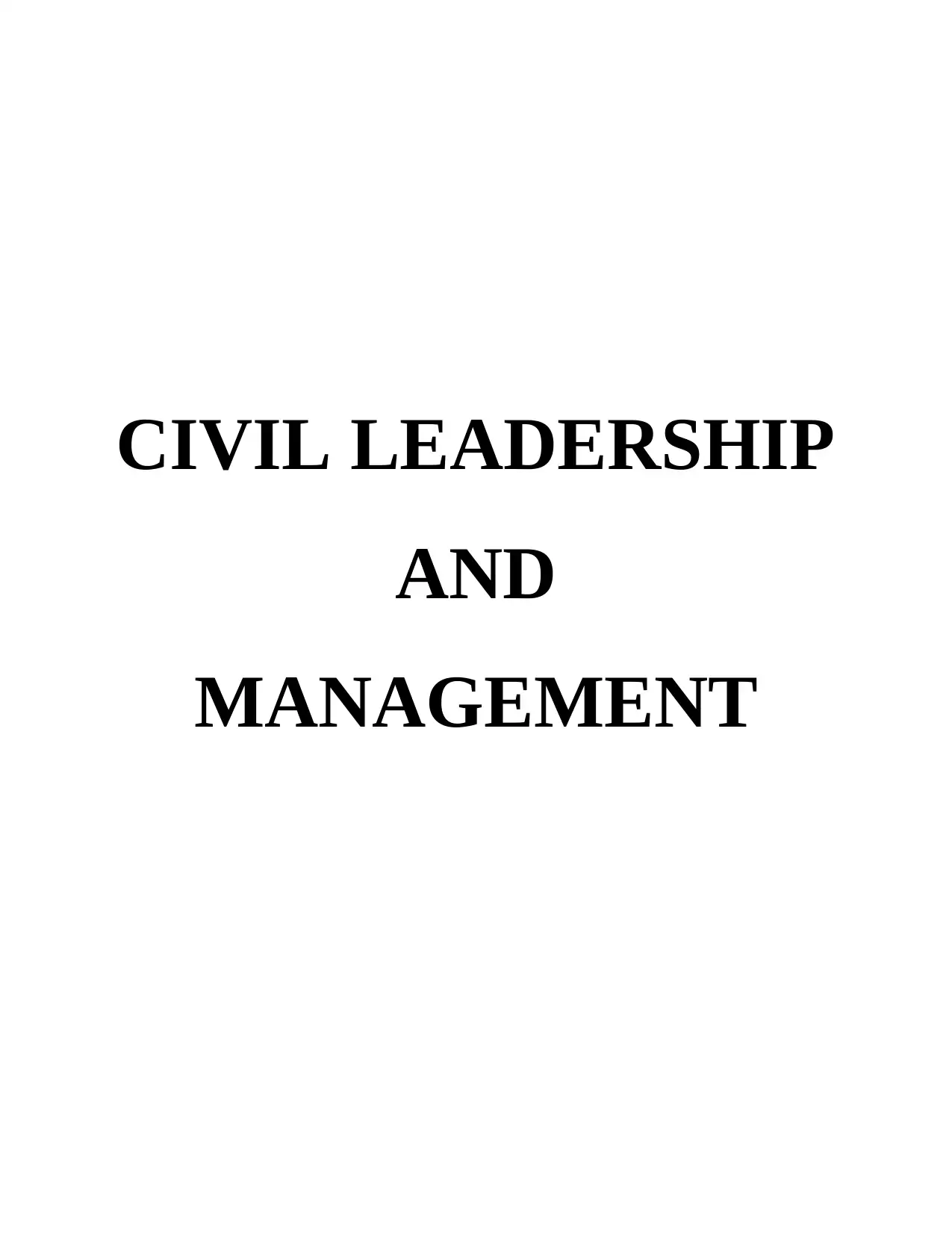
CIVIL LEADERSHIP
AND
MANAGEMENT
AND
MANAGEMENT
Paraphrase This Document
Need a fresh take? Get an instant paraphrase of this document with our AI Paraphraser
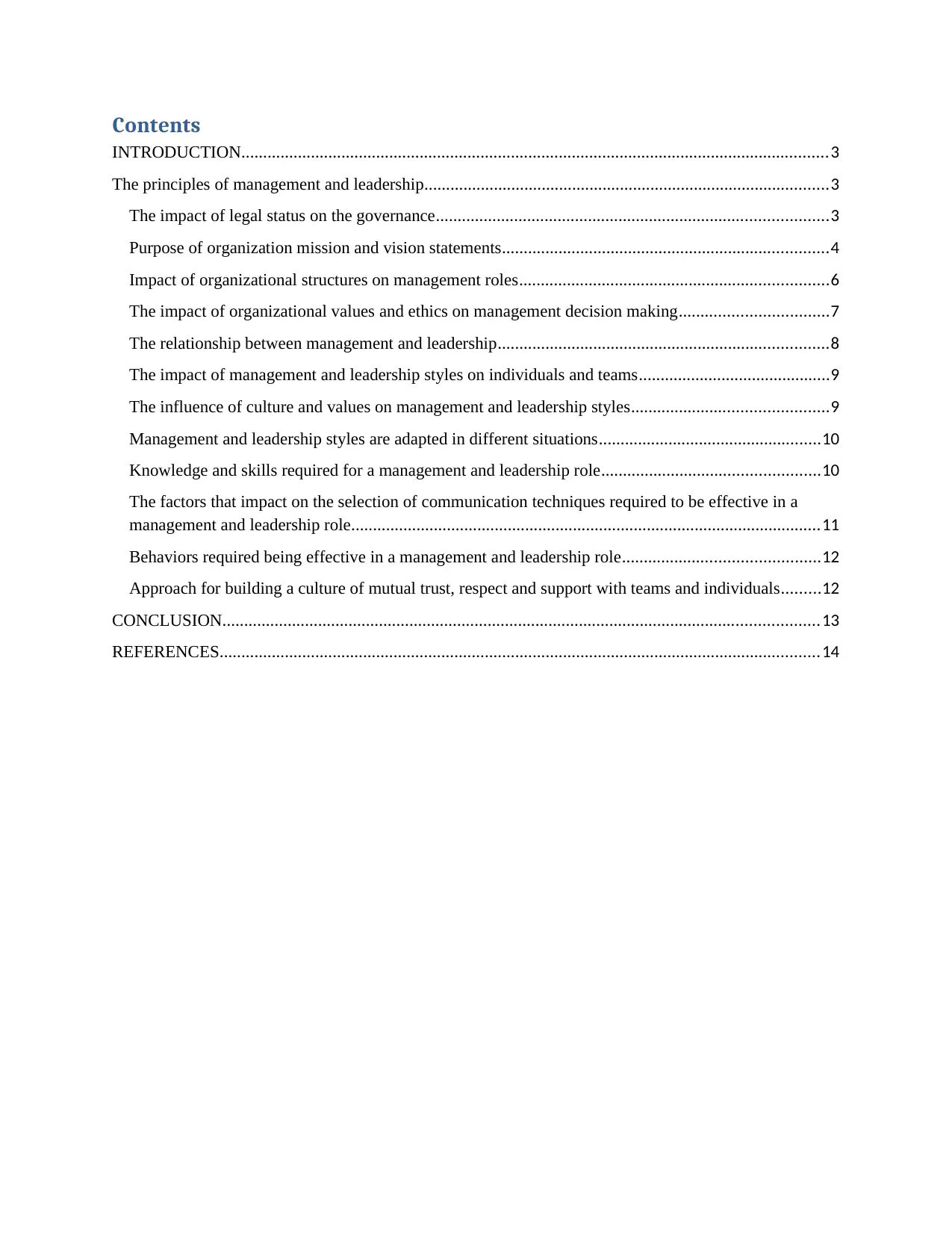
Contents
INTRODUCTION.......................................................................................................................................3
The principles of management and leadership.............................................................................................3
The impact of legal status on the governance..........................................................................................3
Purpose of organization mission and vision statements...........................................................................4
Impact of organizational structures on management roles.......................................................................6
The impact of organizational values and ethics on management decision making..................................7
The relationship between management and leadership............................................................................8
The impact of management and leadership styles on individuals and teams............................................9
The influence of culture and values on management and leadership styles.............................................9
Management and leadership styles are adapted in different situations...................................................10
Knowledge and skills required for a management and leadership role..................................................10
The factors that impact on the selection of communication techniques required to be effective in a
management and leadership role............................................................................................................11
Behaviors required being effective in a management and leadership role.............................................12
Approach for building a culture of mutual trust, respect and support with teams and individuals.........12
CONCLUSION.........................................................................................................................................13
REFERENCES..........................................................................................................................................14
INTRODUCTION.......................................................................................................................................3
The principles of management and leadership.............................................................................................3
The impact of legal status on the governance..........................................................................................3
Purpose of organization mission and vision statements...........................................................................4
Impact of organizational structures on management roles.......................................................................6
The impact of organizational values and ethics on management decision making..................................7
The relationship between management and leadership............................................................................8
The impact of management and leadership styles on individuals and teams............................................9
The influence of culture and values on management and leadership styles.............................................9
Management and leadership styles are adapted in different situations...................................................10
Knowledge and skills required for a management and leadership role..................................................10
The factors that impact on the selection of communication techniques required to be effective in a
management and leadership role............................................................................................................11
Behaviors required being effective in a management and leadership role.............................................12
Approach for building a culture of mutual trust, respect and support with teams and individuals.........12
CONCLUSION.........................................................................................................................................13
REFERENCES..........................................................................................................................................14
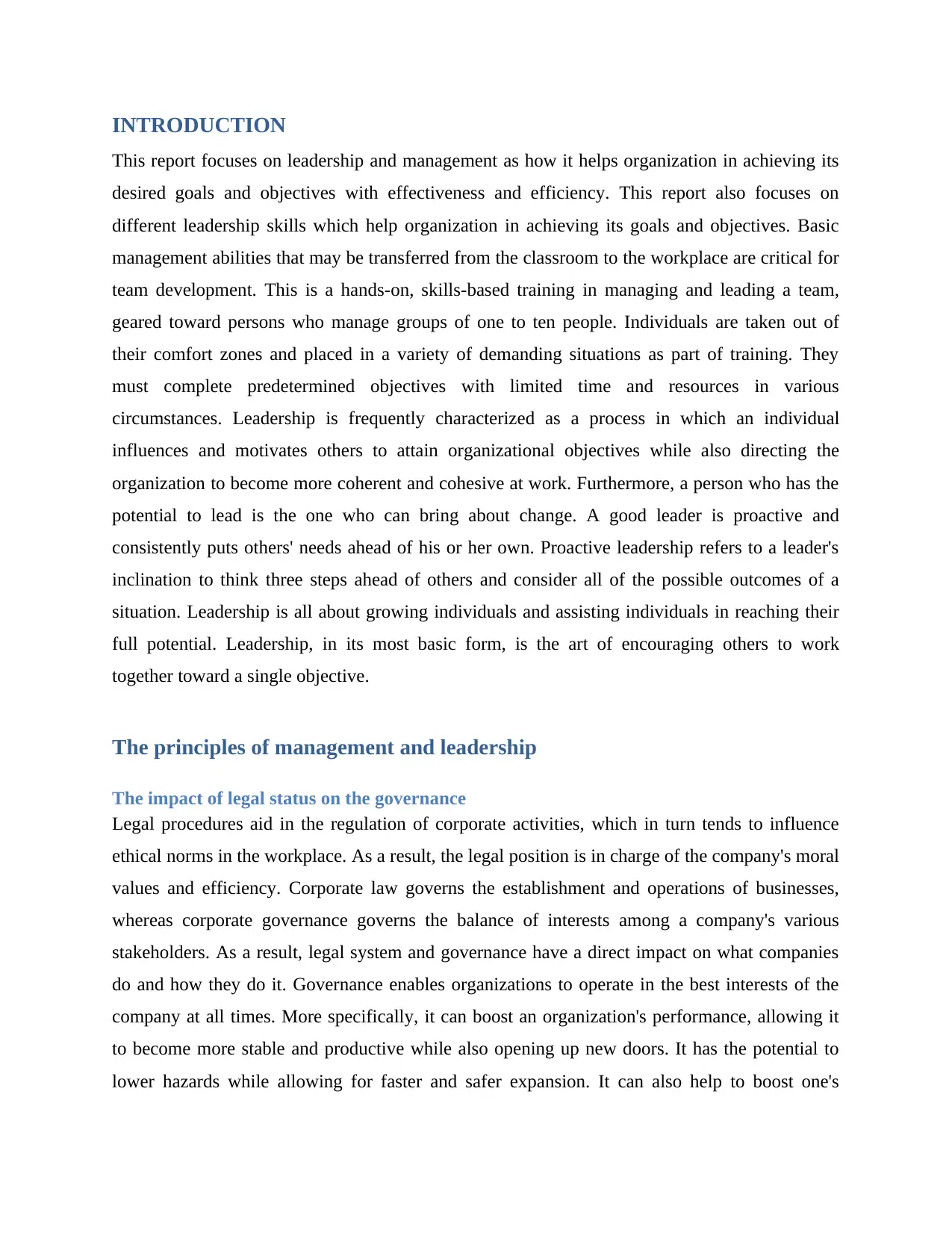
INTRODUCTION
This report focuses on leadership and management as how it helps organization in achieving its
desired goals and objectives with effectiveness and efficiency. This report also focuses on
different leadership skills which help organization in achieving its goals and objectives. Basic
management abilities that may be transferred from the classroom to the workplace are critical for
team development. This is a hands-on, skills-based training in managing and leading a team,
geared toward persons who manage groups of one to ten people. Individuals are taken out of
their comfort zones and placed in a variety of demanding situations as part of training. They
must complete predetermined objectives with limited time and resources in various
circumstances. Leadership is frequently characterized as a process in which an individual
influences and motivates others to attain organizational objectives while also directing the
organization to become more coherent and cohesive at work. Furthermore, a person who has the
potential to lead is the one who can bring about change. A good leader is proactive and
consistently puts others' needs ahead of his or her own. Proactive leadership refers to a leader's
inclination to think three steps ahead of others and consider all of the possible outcomes of a
situation. Leadership is all about growing individuals and assisting individuals in reaching their
full potential. Leadership, in its most basic form, is the art of encouraging others to work
together toward a single objective.
The principles of management and leadership
The impact of legal status on the governance
Legal procedures aid in the regulation of corporate activities, which in turn tends to influence
ethical norms in the workplace. As a result, the legal position is in charge of the company's moral
values and efficiency. Corporate law governs the establishment and operations of businesses,
whereas corporate governance governs the balance of interests among a company's various
stakeholders. As a result, legal system and governance have a direct impact on what companies
do and how they do it. Governance enables organizations to operate in the best interests of the
company at all times. More specifically, it can boost an organization's performance, allowing it
to become more stable and productive while also opening up new doors. It has the potential to
lower hazards while allowing for faster and safer expansion. It can also help to boost one's
This report focuses on leadership and management as how it helps organization in achieving its
desired goals and objectives with effectiveness and efficiency. This report also focuses on
different leadership skills which help organization in achieving its goals and objectives. Basic
management abilities that may be transferred from the classroom to the workplace are critical for
team development. This is a hands-on, skills-based training in managing and leading a team,
geared toward persons who manage groups of one to ten people. Individuals are taken out of
their comfort zones and placed in a variety of demanding situations as part of training. They
must complete predetermined objectives with limited time and resources in various
circumstances. Leadership is frequently characterized as a process in which an individual
influences and motivates others to attain organizational objectives while also directing the
organization to become more coherent and cohesive at work. Furthermore, a person who has the
potential to lead is the one who can bring about change. A good leader is proactive and
consistently puts others' needs ahead of his or her own. Proactive leadership refers to a leader's
inclination to think three steps ahead of others and consider all of the possible outcomes of a
situation. Leadership is all about growing individuals and assisting individuals in reaching their
full potential. Leadership, in its most basic form, is the art of encouraging others to work
together toward a single objective.
The principles of management and leadership
The impact of legal status on the governance
Legal procedures aid in the regulation of corporate activities, which in turn tends to influence
ethical norms in the workplace. As a result, the legal position is in charge of the company's moral
values and efficiency. Corporate law governs the establishment and operations of businesses,
whereas corporate governance governs the balance of interests among a company's various
stakeholders. As a result, legal system and governance have a direct impact on what companies
do and how they do it. Governance enables organizations to operate in the best interests of the
company at all times. More specifically, it can boost an organization's performance, allowing it
to become more stable and productive while also opening up new doors. It has the potential to
lower hazards while allowing for faster and safer expansion. It can also help to boost one's
⊘ This is a preview!⊘
Do you want full access?
Subscribe today to unlock all pages.

Trusted by 1+ million students worldwide
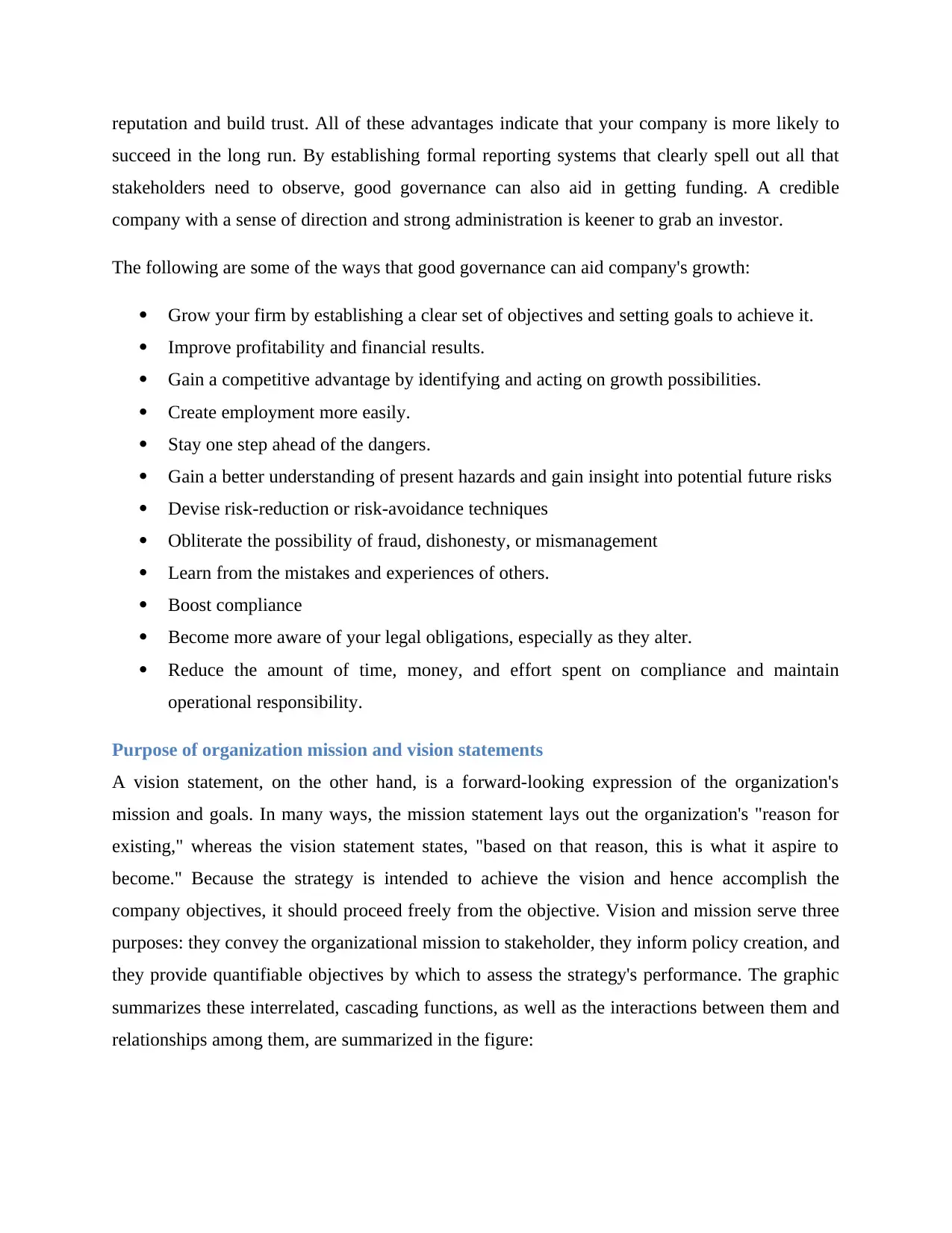
reputation and build trust. All of these advantages indicate that your company is more likely to
succeed in the long run. By establishing formal reporting systems that clearly spell out all that
stakeholders need to observe, good governance can also aid in getting funding. A credible
company with a sense of direction and strong administration is keener to grab an investor.
The following are some of the ways that good governance can aid company's growth:
Grow your firm by establishing a clear set of objectives and setting goals to achieve it.
Improve profitability and financial results.
Gain a competitive advantage by identifying and acting on growth possibilities.
Create employment more easily.
Stay one step ahead of the dangers.
Gain a better understanding of present hazards and gain insight into potential future risks
Devise risk-reduction or risk-avoidance techniques
Obliterate the possibility of fraud, dishonesty, or mismanagement
Learn from the mistakes and experiences of others.
Boost compliance
Become more aware of your legal obligations, especially as they alter.
Reduce the amount of time, money, and effort spent on compliance and maintain
operational responsibility.
Purpose of organization mission and vision statements
A vision statement, on the other hand, is a forward-looking expression of the organization's
mission and goals. In many ways, the mission statement lays out the organization's "reason for
existing," whereas the vision statement states, "based on that reason, this is what it aspire to
become." Because the strategy is intended to achieve the vision and hence accomplish the
company objectives, it should proceed freely from the objective. Vision and mission serve three
purposes: they convey the organizational mission to stakeholder, they inform policy creation, and
they provide quantifiable objectives by which to assess the strategy's performance. The graphic
summarizes these interrelated, cascading functions, as well as the interactions between them and
relationships among them, are summarized in the figure:
succeed in the long run. By establishing formal reporting systems that clearly spell out all that
stakeholders need to observe, good governance can also aid in getting funding. A credible
company with a sense of direction and strong administration is keener to grab an investor.
The following are some of the ways that good governance can aid company's growth:
Grow your firm by establishing a clear set of objectives and setting goals to achieve it.
Improve profitability and financial results.
Gain a competitive advantage by identifying and acting on growth possibilities.
Create employment more easily.
Stay one step ahead of the dangers.
Gain a better understanding of present hazards and gain insight into potential future risks
Devise risk-reduction or risk-avoidance techniques
Obliterate the possibility of fraud, dishonesty, or mismanagement
Learn from the mistakes and experiences of others.
Boost compliance
Become more aware of your legal obligations, especially as they alter.
Reduce the amount of time, money, and effort spent on compliance and maintain
operational responsibility.
Purpose of organization mission and vision statements
A vision statement, on the other hand, is a forward-looking expression of the organization's
mission and goals. In many ways, the mission statement lays out the organization's "reason for
existing," whereas the vision statement states, "based on that reason, this is what it aspire to
become." Because the strategy is intended to achieve the vision and hence accomplish the
company objectives, it should proceed freely from the objective. Vision and mission serve three
purposes: they convey the organizational mission to stakeholder, they inform policy creation, and
they provide quantifiable objectives by which to assess the strategy's performance. The graphic
summarizes these interrelated, cascading functions, as well as the interactions between them and
relationships among them, are summarized in the figure:
Paraphrase This Document
Need a fresh take? Get an instant paraphrase of this document with our AI Paraphraser
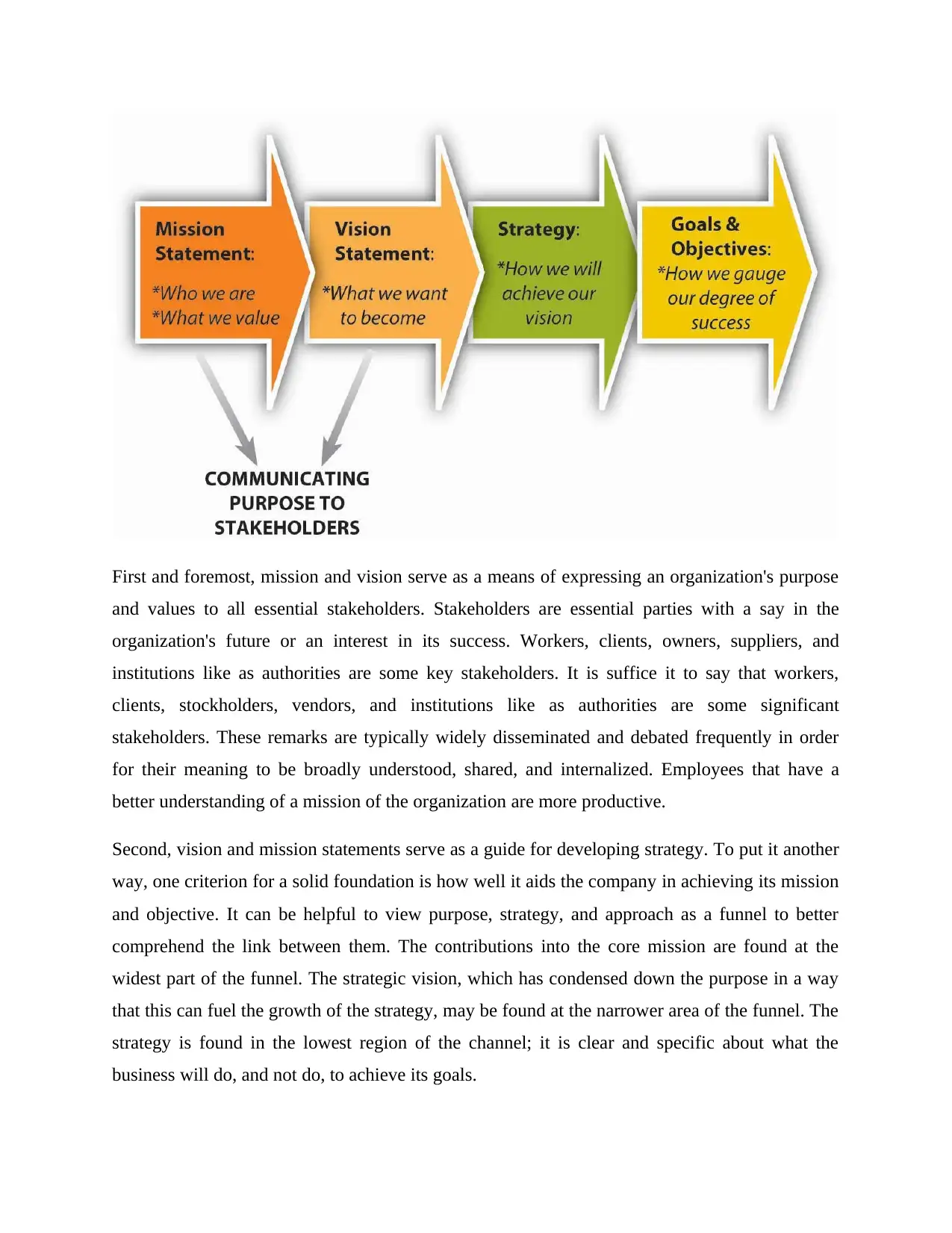
First and foremost, mission and vision serve as a means of expressing an organization's purpose
and values to all essential stakeholders. Stakeholders are essential parties with a say in the
organization's future or an interest in its success. Workers, clients, owners, suppliers, and
institutions like as authorities are some key stakeholders. It is suffice it to say that workers,
clients, stockholders, vendors, and institutions like as authorities are some significant
stakeholders. These remarks are typically widely disseminated and debated frequently in order
for their meaning to be broadly understood, shared, and internalized. Employees that have a
better understanding of a mission of the organization are more productive.
Second, vision and mission statements serve as a guide for developing strategy. To put it another
way, one criterion for a solid foundation is how well it aids the company in achieving its mission
and objective. It can be helpful to view purpose, strategy, and approach as a funnel to better
comprehend the link between them. The contributions into the core mission are found at the
widest part of the funnel. The strategic vision, which has condensed down the purpose in a way
that this can fuel the growth of the strategy, may be found at the narrower area of the funnel. The
strategy is found in the lowest region of the channel; it is clear and specific about what the
business will do, and not do, to achieve its goals.
and values to all essential stakeholders. Stakeholders are essential parties with a say in the
organization's future or an interest in its success. Workers, clients, owners, suppliers, and
institutions like as authorities are some key stakeholders. It is suffice it to say that workers,
clients, stockholders, vendors, and institutions like as authorities are some significant
stakeholders. These remarks are typically widely disseminated and debated frequently in order
for their meaning to be broadly understood, shared, and internalized. Employees that have a
better understanding of a mission of the organization are more productive.
Second, vision and mission statements serve as a guide for developing strategy. To put it another
way, one criterion for a solid foundation is how well it aids the company in achieving its mission
and objective. It can be helpful to view purpose, strategy, and approach as a funnel to better
comprehend the link between them. The contributions into the core mission are found at the
widest part of the funnel. The strategic vision, which has condensed down the purpose in a way
that this can fuel the growth of the strategy, may be found at the narrower area of the funnel. The
strategy is found in the lowest region of the channel; it is clear and specific about what the
business will do, and not do, to achieve its goals.
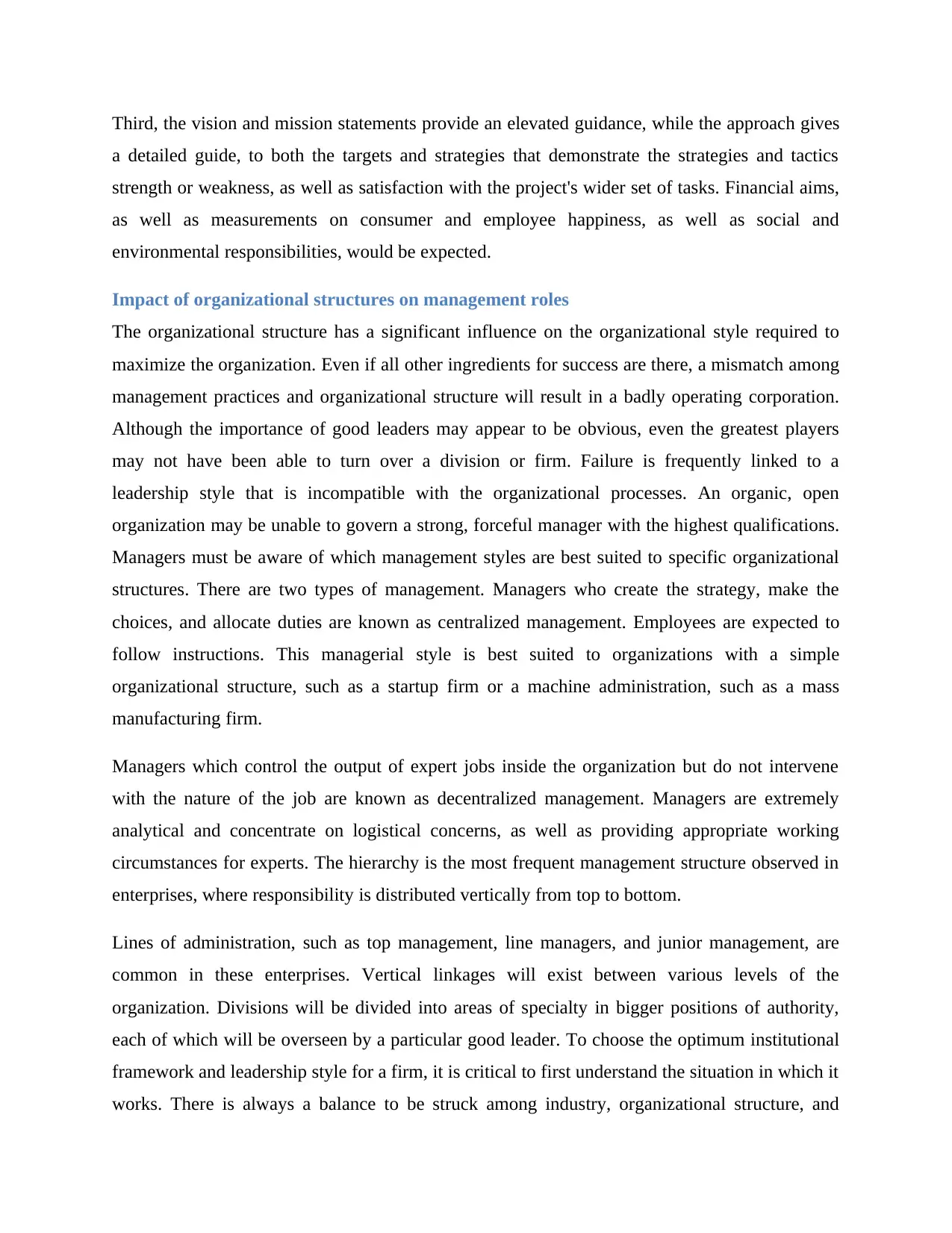
Third, the vision and mission statements provide an elevated guidance, while the approach gives
a detailed guide, to both the targets and strategies that demonstrate the strategies and tactics
strength or weakness, as well as satisfaction with the project's wider set of tasks. Financial aims,
as well as measurements on consumer and employee happiness, as well as social and
environmental responsibilities, would be expected.
Impact of organizational structures on management roles
The organizational structure has a significant influence on the organizational style required to
maximize the organization. Even if all other ingredients for success are there, a mismatch among
management practices and organizational structure will result in a badly operating corporation.
Although the importance of good leaders may appear to be obvious, even the greatest players
may not have been able to turn over a division or firm. Failure is frequently linked to a
leadership style that is incompatible with the organizational processes. An organic, open
organization may be unable to govern a strong, forceful manager with the highest qualifications.
Managers must be aware of which management styles are best suited to specific organizational
structures. There are two types of management. Managers who create the strategy, make the
choices, and allocate duties are known as centralized management. Employees are expected to
follow instructions. This managerial style is best suited to organizations with a simple
organizational structure, such as a startup firm or a machine administration, such as a mass
manufacturing firm.
Managers which control the output of expert jobs inside the organization but do not intervene
with the nature of the job are known as decentralized management. Managers are extremely
analytical and concentrate on logistical concerns, as well as providing appropriate working
circumstances for experts. The hierarchy is the most frequent management structure observed in
enterprises, where responsibility is distributed vertically from top to bottom.
Lines of administration, such as top management, line managers, and junior management, are
common in these enterprises. Vertical linkages will exist between various levels of the
organization. Divisions will be divided into areas of specialty in bigger positions of authority,
each of which will be overseen by a particular good leader. To choose the optimum institutional
framework and leadership style for a firm, it is critical to first understand the situation in which it
works. There is always a balance to be struck among industry, organizational structure, and
a detailed guide, to both the targets and strategies that demonstrate the strategies and tactics
strength or weakness, as well as satisfaction with the project's wider set of tasks. Financial aims,
as well as measurements on consumer and employee happiness, as well as social and
environmental responsibilities, would be expected.
Impact of organizational structures on management roles
The organizational structure has a significant influence on the organizational style required to
maximize the organization. Even if all other ingredients for success are there, a mismatch among
management practices and organizational structure will result in a badly operating corporation.
Although the importance of good leaders may appear to be obvious, even the greatest players
may not have been able to turn over a division or firm. Failure is frequently linked to a
leadership style that is incompatible with the organizational processes. An organic, open
organization may be unable to govern a strong, forceful manager with the highest qualifications.
Managers must be aware of which management styles are best suited to specific organizational
structures. There are two types of management. Managers who create the strategy, make the
choices, and allocate duties are known as centralized management. Employees are expected to
follow instructions. This managerial style is best suited to organizations with a simple
organizational structure, such as a startup firm or a machine administration, such as a mass
manufacturing firm.
Managers which control the output of expert jobs inside the organization but do not intervene
with the nature of the job are known as decentralized management. Managers are extremely
analytical and concentrate on logistical concerns, as well as providing appropriate working
circumstances for experts. The hierarchy is the most frequent management structure observed in
enterprises, where responsibility is distributed vertically from top to bottom.
Lines of administration, such as top management, line managers, and junior management, are
common in these enterprises. Vertical linkages will exist between various levels of the
organization. Divisions will be divided into areas of specialty in bigger positions of authority,
each of which will be overseen by a particular good leader. To choose the optimum institutional
framework and leadership style for a firm, it is critical to first understand the situation in which it
works. There is always a balance to be struck among industry, organizational structure, and
⊘ This is a preview!⊘
Do you want full access?
Subscribe today to unlock all pages.

Trusted by 1+ million students worldwide
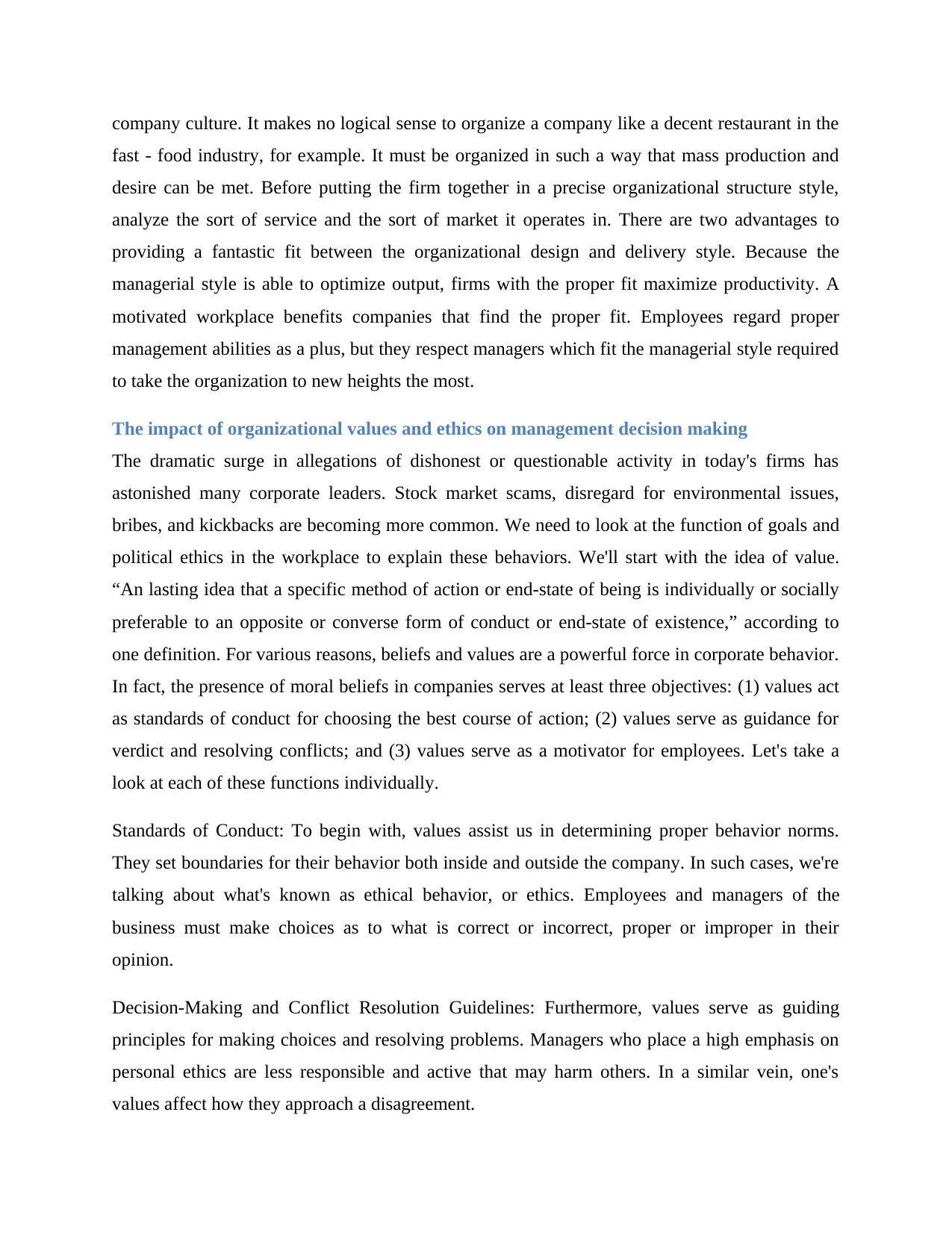
company culture. It makes no logical sense to organize a company like a decent restaurant in the
fast - food industry, for example. It must be organized in such a way that mass production and
desire can be met. Before putting the firm together in a precise organizational structure style,
analyze the sort of service and the sort of market it operates in. There are two advantages to
providing a fantastic fit between the organizational design and delivery style. Because the
managerial style is able to optimize output, firms with the proper fit maximize productivity. A
motivated workplace benefits companies that find the proper fit. Employees regard proper
management abilities as a plus, but they respect managers which fit the managerial style required
to take the organization to new heights the most.
The impact of organizational values and ethics on management decision making
The dramatic surge in allegations of dishonest or questionable activity in today's firms has
astonished many corporate leaders. Stock market scams, disregard for environmental issues,
bribes, and kickbacks are becoming more common. We need to look at the function of goals and
political ethics in the workplace to explain these behaviors. We'll start with the idea of value.
“An lasting idea that a specific method of action or end-state of being is individually or socially
preferable to an opposite or converse form of conduct or end-state of existence,” according to
one definition. For various reasons, beliefs and values are a powerful force in corporate behavior.
In fact, the presence of moral beliefs in companies serves at least three objectives: (1) values act
as standards of conduct for choosing the best course of action; (2) values serve as guidance for
verdict and resolving conflicts; and (3) values serve as a motivator for employees. Let's take a
look at each of these functions individually.
Standards of Conduct: To begin with, values assist us in determining proper behavior norms.
They set boundaries for their behavior both inside and outside the company. In such cases, we're
talking about what's known as ethical behavior, or ethics. Employees and managers of the
business must make choices as to what is correct or incorrect, proper or improper in their
opinion.
Decision-Making and Conflict Resolution Guidelines: Furthermore, values serve as guiding
principles for making choices and resolving problems. Managers who place a high emphasis on
personal ethics are less responsible and active that may harm others. In a similar vein, one's
values affect how they approach a disagreement.
fast - food industry, for example. It must be organized in such a way that mass production and
desire can be met. Before putting the firm together in a precise organizational structure style,
analyze the sort of service and the sort of market it operates in. There are two advantages to
providing a fantastic fit between the organizational design and delivery style. Because the
managerial style is able to optimize output, firms with the proper fit maximize productivity. A
motivated workplace benefits companies that find the proper fit. Employees regard proper
management abilities as a plus, but they respect managers which fit the managerial style required
to take the organization to new heights the most.
The impact of organizational values and ethics on management decision making
The dramatic surge in allegations of dishonest or questionable activity in today's firms has
astonished many corporate leaders. Stock market scams, disregard for environmental issues,
bribes, and kickbacks are becoming more common. We need to look at the function of goals and
political ethics in the workplace to explain these behaviors. We'll start with the idea of value.
“An lasting idea that a specific method of action or end-state of being is individually or socially
preferable to an opposite or converse form of conduct or end-state of existence,” according to
one definition. For various reasons, beliefs and values are a powerful force in corporate behavior.
In fact, the presence of moral beliefs in companies serves at least three objectives: (1) values act
as standards of conduct for choosing the best course of action; (2) values serve as guidance for
verdict and resolving conflicts; and (3) values serve as a motivator for employees. Let's take a
look at each of these functions individually.
Standards of Conduct: To begin with, values assist us in determining proper behavior norms.
They set boundaries for their behavior both inside and outside the company. In such cases, we're
talking about what's known as ethical behavior, or ethics. Employees and managers of the
business must make choices as to what is correct or incorrect, proper or improper in their
opinion.
Decision-Making and Conflict Resolution Guidelines: Furthermore, values serve as guiding
principles for making choices and resolving problems. Managers who place a high emphasis on
personal ethics are less responsible and active that may harm others. In a similar vein, one's
values affect how they approach a disagreement.
Paraphrase This Document
Need a fresh take? Get an instant paraphrase of this document with our AI Paraphraser
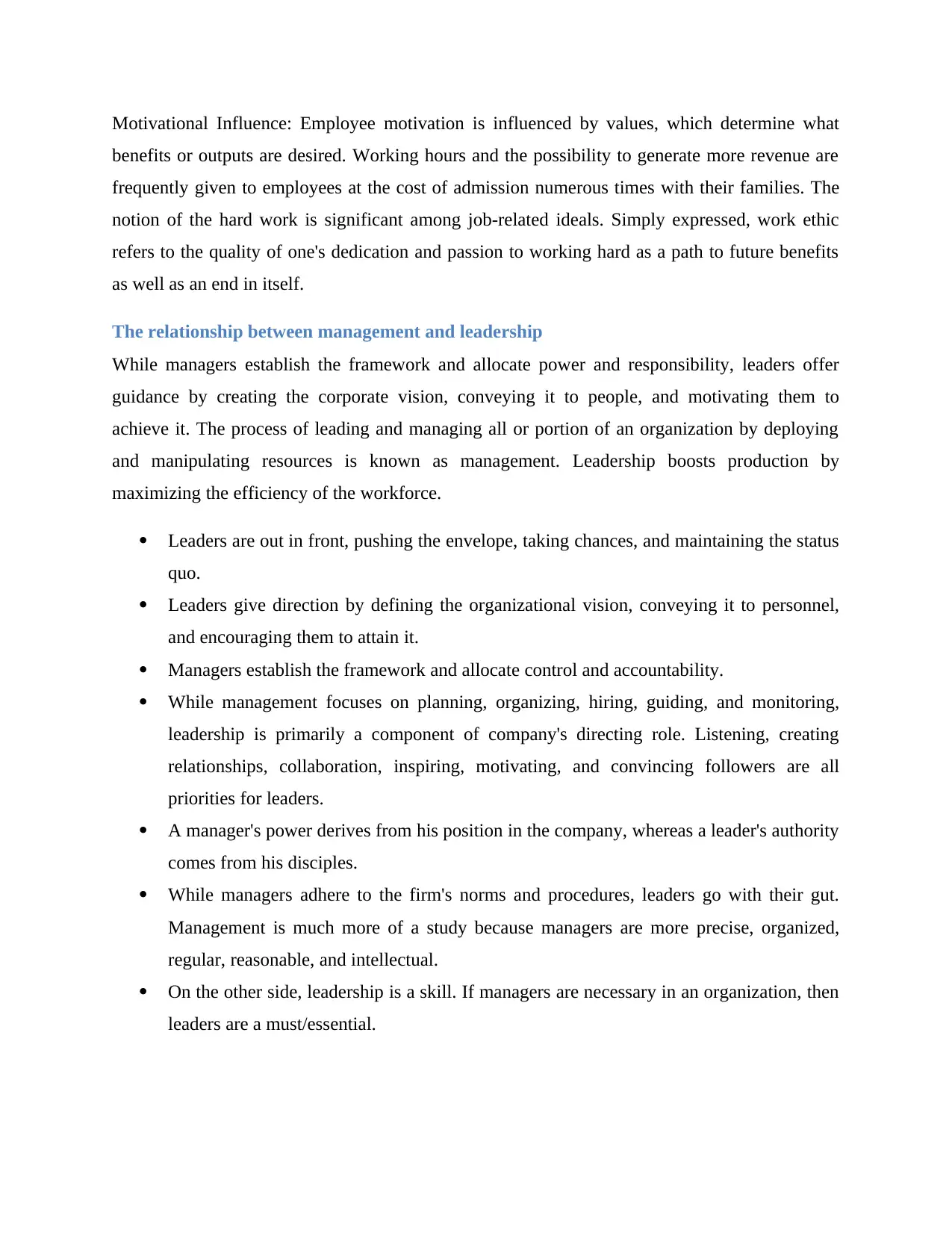
Motivational Influence: Employee motivation is influenced by values, which determine what
benefits or outputs are desired. Working hours and the possibility to generate more revenue are
frequently given to employees at the cost of admission numerous times with their families. The
notion of the hard work is significant among job-related ideals. Simply expressed, work ethic
refers to the quality of one's dedication and passion to working hard as a path to future benefits
as well as an end in itself.
The relationship between management and leadership
While managers establish the framework and allocate power and responsibility, leaders offer
guidance by creating the corporate vision, conveying it to people, and motivating them to
achieve it. The process of leading and managing all or portion of an organization by deploying
and manipulating resources is known as management. Leadership boosts production by
maximizing the efficiency of the workforce.
Leaders are out in front, pushing the envelope, taking chances, and maintaining the status
quo.
Leaders give direction by defining the organizational vision, conveying it to personnel,
and encouraging them to attain it.
Managers establish the framework and allocate control and accountability.
While management focuses on planning, organizing, hiring, guiding, and monitoring,
leadership is primarily a component of company's directing role. Listening, creating
relationships, collaboration, inspiring, motivating, and convincing followers are all
priorities for leaders.
A manager's power derives from his position in the company, whereas a leader's authority
comes from his disciples.
While managers adhere to the firm's norms and procedures, leaders go with their gut.
Management is much more of a study because managers are more precise, organized,
regular, reasonable, and intellectual.
On the other side, leadership is a skill. If managers are necessary in an organization, then
leaders are a must/essential.
benefits or outputs are desired. Working hours and the possibility to generate more revenue are
frequently given to employees at the cost of admission numerous times with their families. The
notion of the hard work is significant among job-related ideals. Simply expressed, work ethic
refers to the quality of one's dedication and passion to working hard as a path to future benefits
as well as an end in itself.
The relationship between management and leadership
While managers establish the framework and allocate power and responsibility, leaders offer
guidance by creating the corporate vision, conveying it to people, and motivating them to
achieve it. The process of leading and managing all or portion of an organization by deploying
and manipulating resources is known as management. Leadership boosts production by
maximizing the efficiency of the workforce.
Leaders are out in front, pushing the envelope, taking chances, and maintaining the status
quo.
Leaders give direction by defining the organizational vision, conveying it to personnel,
and encouraging them to attain it.
Managers establish the framework and allocate control and accountability.
While management focuses on planning, organizing, hiring, guiding, and monitoring,
leadership is primarily a component of company's directing role. Listening, creating
relationships, collaboration, inspiring, motivating, and convincing followers are all
priorities for leaders.
A manager's power derives from his position in the company, whereas a leader's authority
comes from his disciples.
While managers adhere to the firm's norms and procedures, leaders go with their gut.
Management is much more of a study because managers are more precise, organized,
regular, reasonable, and intellectual.
On the other side, leadership is a skill. If managers are necessary in an organization, then
leaders are a must/essential.
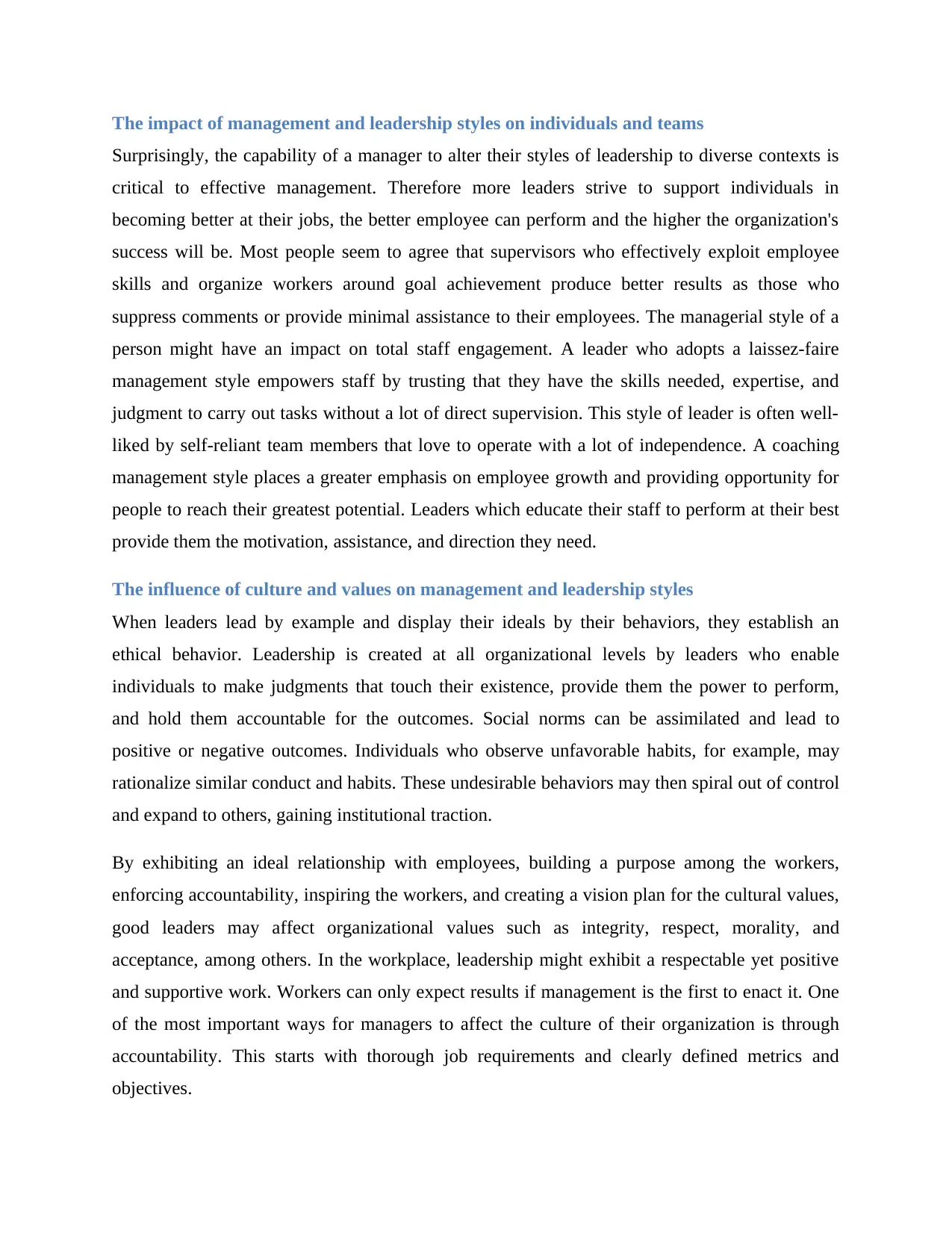
The impact of management and leadership styles on individuals and teams
Surprisingly, the capability of a manager to alter their styles of leadership to diverse contexts is
critical to effective management. Therefore more leaders strive to support individuals in
becoming better at their jobs, the better employee can perform and the higher the organization's
success will be. Most people seem to agree that supervisors who effectively exploit employee
skills and organize workers around goal achievement produce better results as those who
suppress comments or provide minimal assistance to their employees. The managerial style of a
person might have an impact on total staff engagement. A leader who adopts a laissez-faire
management style empowers staff by trusting that they have the skills needed, expertise, and
judgment to carry out tasks without a lot of direct supervision. This style of leader is often well-
liked by self-reliant team members that love to operate with a lot of independence. A coaching
management style places a greater emphasis on employee growth and providing opportunity for
people to reach their greatest potential. Leaders which educate their staff to perform at their best
provide them the motivation, assistance, and direction they need.
The influence of culture and values on management and leadership styles
When leaders lead by example and display their ideals by their behaviors, they establish an
ethical behavior. Leadership is created at all organizational levels by leaders who enable
individuals to make judgments that touch their existence, provide them the power to perform,
and hold them accountable for the outcomes. Social norms can be assimilated and lead to
positive or negative outcomes. Individuals who observe unfavorable habits, for example, may
rationalize similar conduct and habits. These undesirable behaviors may then spiral out of control
and expand to others, gaining institutional traction.
By exhibiting an ideal relationship with employees, building a purpose among the workers,
enforcing accountability, inspiring the workers, and creating a vision plan for the cultural values,
good leaders may affect organizational values such as integrity, respect, morality, and
acceptance, among others. In the workplace, leadership might exhibit a respectable yet positive
and supportive work. Workers can only expect results if management is the first to enact it. One
of the most important ways for managers to affect the culture of their organization is through
accountability. This starts with thorough job requirements and clearly defined metrics and
objectives.
Surprisingly, the capability of a manager to alter their styles of leadership to diverse contexts is
critical to effective management. Therefore more leaders strive to support individuals in
becoming better at their jobs, the better employee can perform and the higher the organization's
success will be. Most people seem to agree that supervisors who effectively exploit employee
skills and organize workers around goal achievement produce better results as those who
suppress comments or provide minimal assistance to their employees. The managerial style of a
person might have an impact on total staff engagement. A leader who adopts a laissez-faire
management style empowers staff by trusting that they have the skills needed, expertise, and
judgment to carry out tasks without a lot of direct supervision. This style of leader is often well-
liked by self-reliant team members that love to operate with a lot of independence. A coaching
management style places a greater emphasis on employee growth and providing opportunity for
people to reach their greatest potential. Leaders which educate their staff to perform at their best
provide them the motivation, assistance, and direction they need.
The influence of culture and values on management and leadership styles
When leaders lead by example and display their ideals by their behaviors, they establish an
ethical behavior. Leadership is created at all organizational levels by leaders who enable
individuals to make judgments that touch their existence, provide them the power to perform,
and hold them accountable for the outcomes. Social norms can be assimilated and lead to
positive or negative outcomes. Individuals who observe unfavorable habits, for example, may
rationalize similar conduct and habits. These undesirable behaviors may then spiral out of control
and expand to others, gaining institutional traction.
By exhibiting an ideal relationship with employees, building a purpose among the workers,
enforcing accountability, inspiring the workers, and creating a vision plan for the cultural values,
good leaders may affect organizational values such as integrity, respect, morality, and
acceptance, among others. In the workplace, leadership might exhibit a respectable yet positive
and supportive work. Workers can only expect results if management is the first to enact it. One
of the most important ways for managers to affect the culture of their organization is through
accountability. This starts with thorough job requirements and clearly defined metrics and
objectives.
⊘ This is a preview!⊘
Do you want full access?
Subscribe today to unlock all pages.

Trusted by 1+ million students worldwide
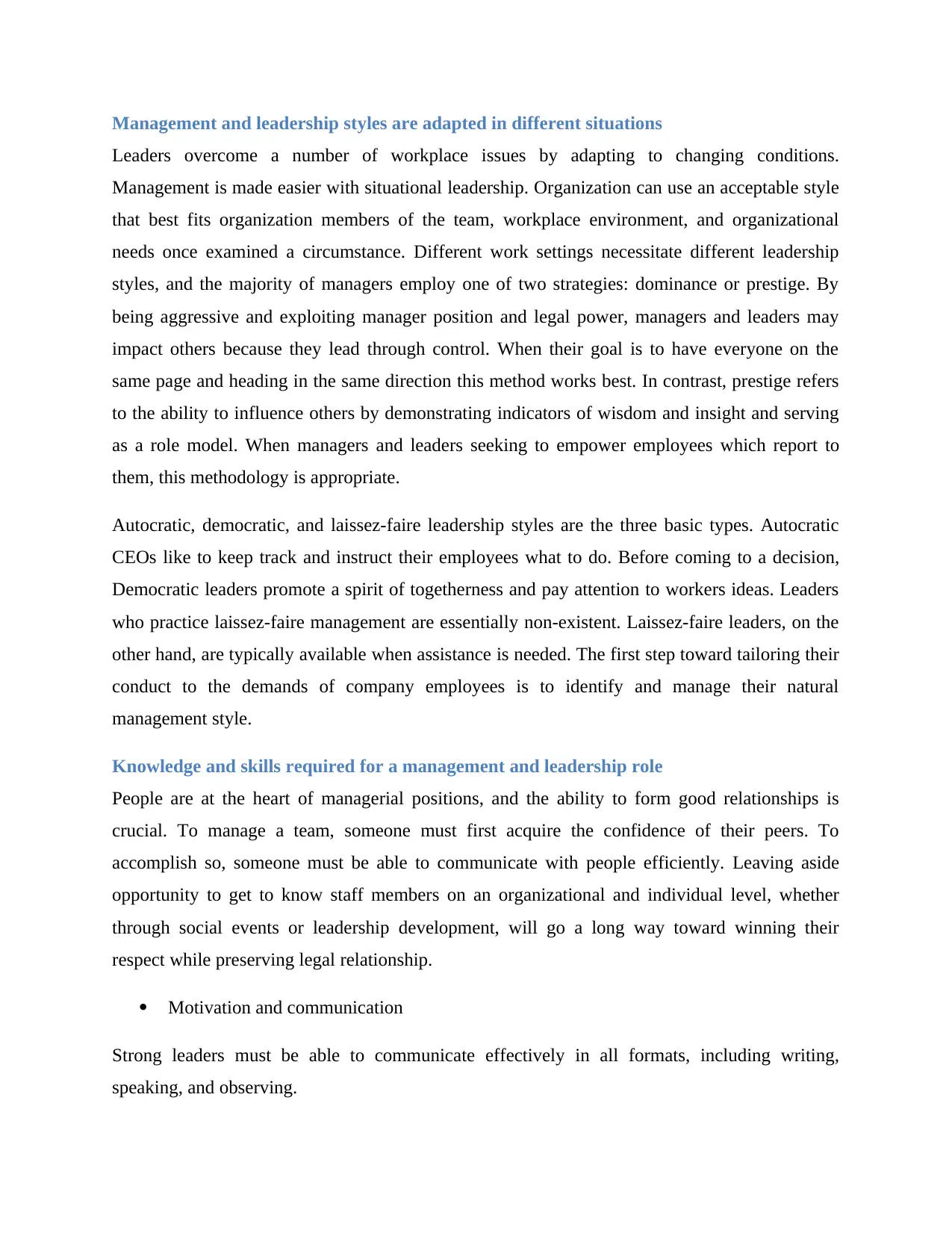
Management and leadership styles are adapted in different situations
Leaders overcome a number of workplace issues by adapting to changing conditions.
Management is made easier with situational leadership. Organization can use an acceptable style
that best fits organization members of the team, workplace environment, and organizational
needs once examined a circumstance. Different work settings necessitate different leadership
styles, and the majority of managers employ one of two strategies: dominance or prestige. By
being aggressive and exploiting manager position and legal power, managers and leaders may
impact others because they lead through control. When their goal is to have everyone on the
same page and heading in the same direction this method works best. In contrast, prestige refers
to the ability to influence others by demonstrating indicators of wisdom and insight and serving
as a role model. When managers and leaders seeking to empower employees which report to
them, this methodology is appropriate.
Autocratic, democratic, and laissez-faire leadership styles are the three basic types. Autocratic
CEOs like to keep track and instruct their employees what to do. Before coming to a decision,
Democratic leaders promote a spirit of togetherness and pay attention to workers ideas. Leaders
who practice laissez-faire management are essentially non-existent. Laissez-faire leaders, on the
other hand, are typically available when assistance is needed. The first step toward tailoring their
conduct to the demands of company employees is to identify and manage their natural
management style.
Knowledge and skills required for a management and leadership role
People are at the heart of managerial positions, and the ability to form good relationships is
crucial. To manage a team, someone must first acquire the confidence of their peers. To
accomplish so, someone must be able to communicate with people efficiently. Leaving aside
opportunity to get to know staff members on an organizational and individual level, whether
through social events or leadership development, will go a long way toward winning their
respect while preserving legal relationship.
Motivation and communication
Strong leaders must be able to communicate effectively in all formats, including writing,
speaking, and observing.
Leaders overcome a number of workplace issues by adapting to changing conditions.
Management is made easier with situational leadership. Organization can use an acceptable style
that best fits organization members of the team, workplace environment, and organizational
needs once examined a circumstance. Different work settings necessitate different leadership
styles, and the majority of managers employ one of two strategies: dominance or prestige. By
being aggressive and exploiting manager position and legal power, managers and leaders may
impact others because they lead through control. When their goal is to have everyone on the
same page and heading in the same direction this method works best. In contrast, prestige refers
to the ability to influence others by demonstrating indicators of wisdom and insight and serving
as a role model. When managers and leaders seeking to empower employees which report to
them, this methodology is appropriate.
Autocratic, democratic, and laissez-faire leadership styles are the three basic types. Autocratic
CEOs like to keep track and instruct their employees what to do. Before coming to a decision,
Democratic leaders promote a spirit of togetherness and pay attention to workers ideas. Leaders
who practice laissez-faire management are essentially non-existent. Laissez-faire leaders, on the
other hand, are typically available when assistance is needed. The first step toward tailoring their
conduct to the demands of company employees is to identify and manage their natural
management style.
Knowledge and skills required for a management and leadership role
People are at the heart of managerial positions, and the ability to form good relationships is
crucial. To manage a team, someone must first acquire the confidence of their peers. To
accomplish so, someone must be able to communicate with people efficiently. Leaving aside
opportunity to get to know staff members on an organizational and individual level, whether
through social events or leadership development, will go a long way toward winning their
respect while preserving legal relationship.
Motivation and communication
Strong leaders must be able to communicate effectively in all formats, including writing,
speaking, and observing.
Paraphrase This Document
Need a fresh take? Get an instant paraphrase of this document with our AI Paraphraser
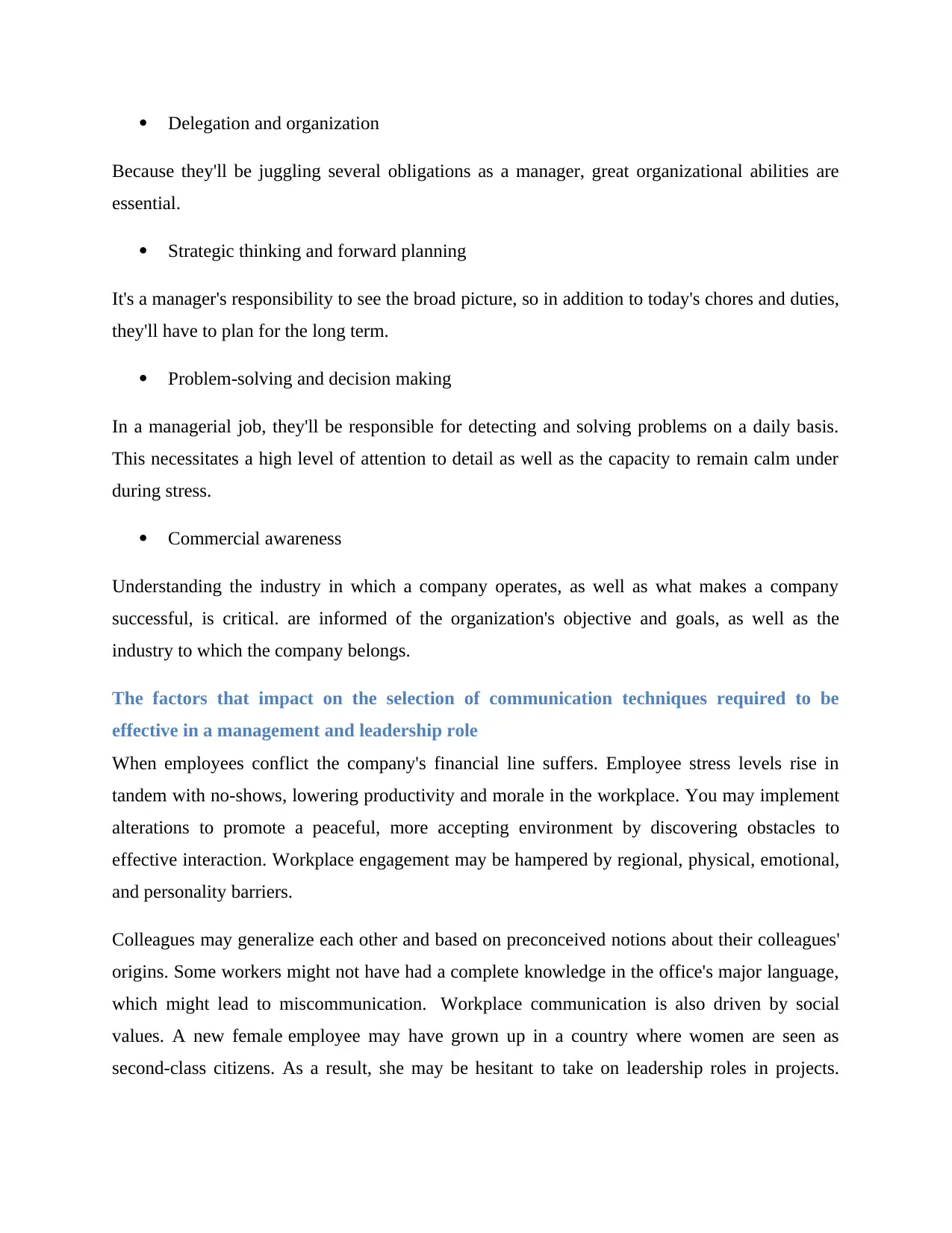
Delegation and organization
Because they'll be juggling several obligations as a manager, great organizational abilities are
essential.
Strategic thinking and forward planning
It's a manager's responsibility to see the broad picture, so in addition to today's chores and duties,
they'll have to plan for the long term.
Problem-solving and decision making
In a managerial job, they'll be responsible for detecting and solving problems on a daily basis.
This necessitates a high level of attention to detail as well as the capacity to remain calm under
during stress.
Commercial awareness
Understanding the industry in which a company operates, as well as what makes a company
successful, is critical. are informed of the organization's objective and goals, as well as the
industry to which the company belongs.
The factors that impact on the selection of communication techniques required to be
effective in a management and leadership role
When employees conflict the company's financial line suffers. Employee stress levels rise in
tandem with no-shows, lowering productivity and morale in the workplace. You may implement
alterations to promote a peaceful, more accepting environment by discovering obstacles to
effective interaction. Workplace engagement may be hampered by regional, physical, emotional,
and personality barriers.
Colleagues may generalize each other and based on preconceived notions about their colleagues'
origins. Some workers might not have had a complete knowledge in the office's major language,
which might lead to miscommunication. Workplace communication is also driven by social
values. A new female employee may have grown up in a country where women are seen as
second-class citizens. As a result, she may be hesitant to take on leadership roles in projects.
Because they'll be juggling several obligations as a manager, great organizational abilities are
essential.
Strategic thinking and forward planning
It's a manager's responsibility to see the broad picture, so in addition to today's chores and duties,
they'll have to plan for the long term.
Problem-solving and decision making
In a managerial job, they'll be responsible for detecting and solving problems on a daily basis.
This necessitates a high level of attention to detail as well as the capacity to remain calm under
during stress.
Commercial awareness
Understanding the industry in which a company operates, as well as what makes a company
successful, is critical. are informed of the organization's objective and goals, as well as the
industry to which the company belongs.
The factors that impact on the selection of communication techniques required to be
effective in a management and leadership role
When employees conflict the company's financial line suffers. Employee stress levels rise in
tandem with no-shows, lowering productivity and morale in the workplace. You may implement
alterations to promote a peaceful, more accepting environment by discovering obstacles to
effective interaction. Workplace engagement may be hampered by regional, physical, emotional,
and personality barriers.
Colleagues may generalize each other and based on preconceived notions about their colleagues'
origins. Some workers might not have had a complete knowledge in the office's major language,
which might lead to miscommunication. Workplace communication is also driven by social
values. A new female employee may have grown up in a country where women are seen as
second-class citizens. As a result, she may be hesitant to take on leadership roles in projects.
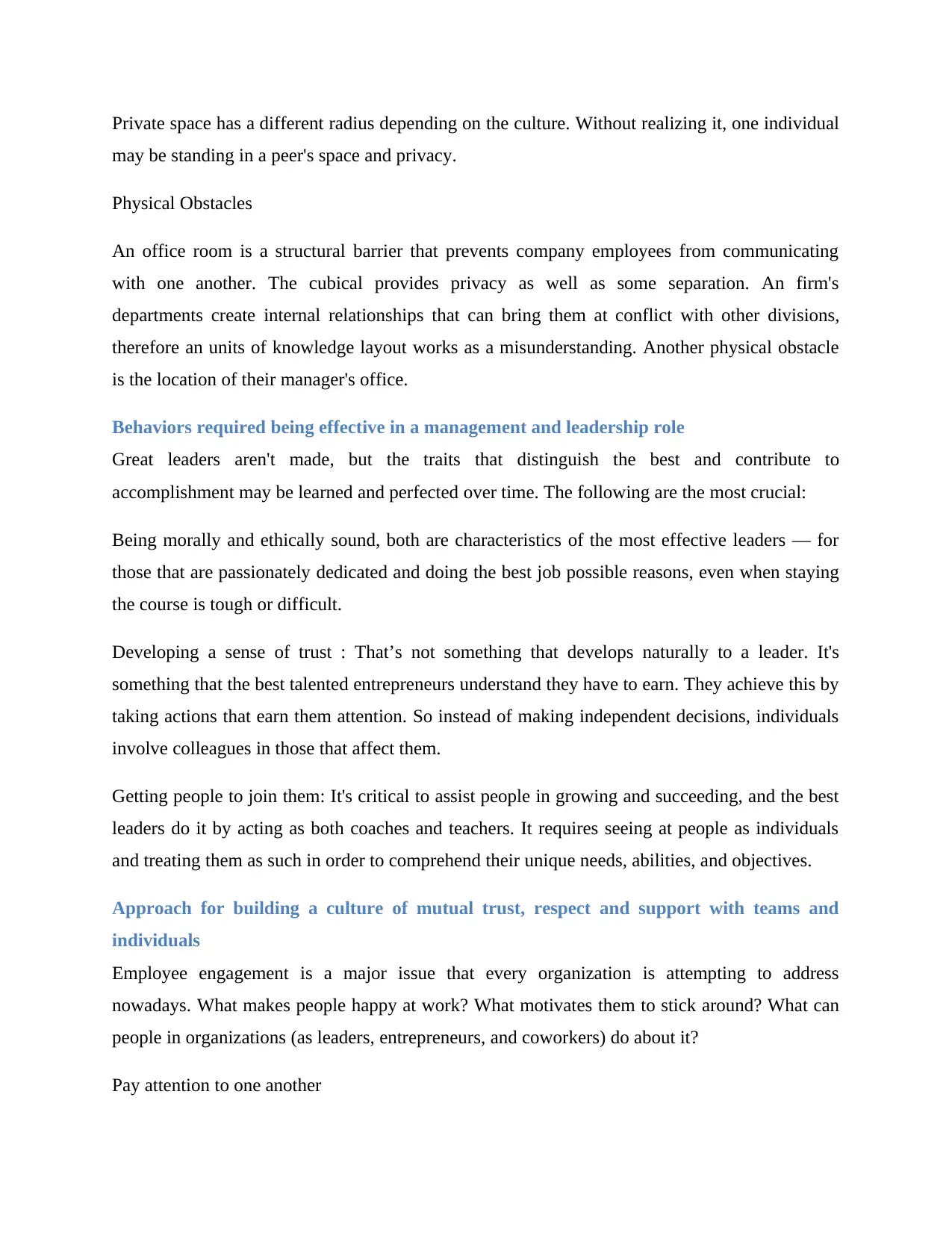
Private space has a different radius depending on the culture. Without realizing it, one individual
may be standing in a peer's space and privacy.
Physical Obstacles
An office room is a structural barrier that prevents company employees from communicating
with one another. The cubical provides privacy as well as some separation. An firm's
departments create internal relationships that can bring them at conflict with other divisions,
therefore an units of knowledge layout works as a misunderstanding. Another physical obstacle
is the location of their manager's office.
Behaviors required being effective in a management and leadership role
Great leaders aren't made, but the traits that distinguish the best and contribute to
accomplishment may be learned and perfected over time. The following are the most crucial:
Being morally and ethically sound, both are characteristics of the most effective leaders — for
those that are passionately dedicated and doing the best job possible reasons, even when staying
the course is tough or difficult.
Developing a sense of trust : That’s not something that develops naturally to a leader. It's
something that the best talented entrepreneurs understand they have to earn. They achieve this by
taking actions that earn them attention. So instead of making independent decisions, individuals
involve colleagues in those that affect them.
Getting people to join them: It's critical to assist people in growing and succeeding, and the best
leaders do it by acting as both coaches and teachers. It requires seeing at people as individuals
and treating them as such in order to comprehend their unique needs, abilities, and objectives.
Approach for building a culture of mutual trust, respect and support with teams and
individuals
Employee engagement is a major issue that every organization is attempting to address
nowadays. What makes people happy at work? What motivates them to stick around? What can
people in organizations (as leaders, entrepreneurs, and coworkers) do about it?
Pay attention to one another
may be standing in a peer's space and privacy.
Physical Obstacles
An office room is a structural barrier that prevents company employees from communicating
with one another. The cubical provides privacy as well as some separation. An firm's
departments create internal relationships that can bring them at conflict with other divisions,
therefore an units of knowledge layout works as a misunderstanding. Another physical obstacle
is the location of their manager's office.
Behaviors required being effective in a management and leadership role
Great leaders aren't made, but the traits that distinguish the best and contribute to
accomplishment may be learned and perfected over time. The following are the most crucial:
Being morally and ethically sound, both are characteristics of the most effective leaders — for
those that are passionately dedicated and doing the best job possible reasons, even when staying
the course is tough or difficult.
Developing a sense of trust : That’s not something that develops naturally to a leader. It's
something that the best talented entrepreneurs understand they have to earn. They achieve this by
taking actions that earn them attention. So instead of making independent decisions, individuals
involve colleagues in those that affect them.
Getting people to join them: It's critical to assist people in growing and succeeding, and the best
leaders do it by acting as both coaches and teachers. It requires seeing at people as individuals
and treating them as such in order to comprehend their unique needs, abilities, and objectives.
Approach for building a culture of mutual trust, respect and support with teams and
individuals
Employee engagement is a major issue that every organization is attempting to address
nowadays. What makes people happy at work? What motivates them to stick around? What can
people in organizations (as leaders, entrepreneurs, and coworkers) do about it?
Pay attention to one another
⊘ This is a preview!⊘
Do you want full access?
Subscribe today to unlock all pages.

Trusted by 1+ million students worldwide
1 out of 15
Related Documents
Your All-in-One AI-Powered Toolkit for Academic Success.
+13062052269
info@desklib.com
Available 24*7 on WhatsApp / Email
![[object Object]](/_next/static/media/star-bottom.7253800d.svg)
Unlock your academic potential
Copyright © 2020–2025 A2Z Services. All Rights Reserved. Developed and managed by ZUCOL.





